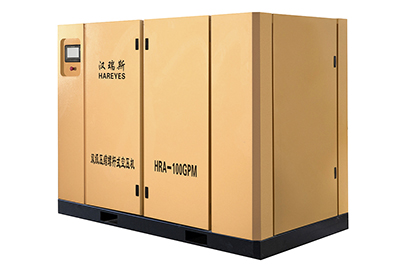about us
Guangdong Hareyes Compressor Manufacturing Co., Ltd.
Address:Building 6, No.27 Zhenma Road, Dalingshan Town, Dongguan City
Phone:+86-400-830-6698
E-mail:mark@rrtmachine.com
Products:Screw air compressor, refrigeration dryer, adsorption dryer, etc.

The selection and matching of thermal expansion valves have an important effect on the function of the entire air compressor operating system. The correct selection of the thermal expansion valve will make full use of the evaporator, so that the evaporator always matches the thermal load.
Mismatch between thermal expansion valve and system
When there is a mismatch, the refrigerant flow rate of the system will be more or less, which will cause the cooling capacity of the thermal expansion valve to increase or decrease.
1. When the opening of the thermal expansion valve is too small, the refrigerant supply is lacking, and there is no satisfactory refrigerant evaporation in the evaporator, so that the refrigerant evaporates by flowing into the evaporator tube. After that, no liquid refrigerant evaporates in the evaporator pipe, as long as the vapor is overheated. Therefore, an appropriate part of the evaporator fails to give full play to its efficiency, resulting in a lack of air conditioning cooling capacity, slow cooling speed, and reduced cooling effect, which will have a negative impact on the function of the system.
2. Assuming that the opening of the thermal expansion valve is too large, that is, the amount of liquid supplied by the thermal expansion valve to the evaporator is greater than the load of the evaporator. Some liquid refrigerant will evaporate in the evaporator and enter the compressor together with the gaseous refrigerant. The formation of liquid hammer (wet stroke), and even cylinder shock, damage the compressor. In addition, when the refrigeration capacity is too large, it will cause vibration, and excessive liquid will be supplied to the evaporator intermittently, causing the suction pressure of the compressor to fluctuate sharply. At the same time, the opening of the thermal expansion valve is too large, which increases the evaporation temperature, reduces the cooling capacity, increases the power consumption of the compressor, and increases the power consumption.
For the selection of the thermal expansion valve, it is necessary to refer to the type of refrigerant in the refrigeration system, the size of the sweating temperature, and the size of the superheating load of the sweating device. Confirm the following points when choosing:
1. Confirm the pressure drop of the valve.
The difference between condensing pressure and transpiration pressure. The net pressure drop of the valve is obtained by subtracting all other pressure losses from this difference. However, all possible sources of pressure drop should be considered:
(1) Friction loss when flowing through refrigerant pipes (including condenser and evaporator).
(2) The pressure drop when flowing through liquid pipe fittings (such as solenoid valves and dryers).
(3) Static electricity-the pressure drop (rise) caused by the vertical rise (fall) of the liquid pipe, and the pressure drop (rise) when passing through the refrigerant distributor (if a distributor is used).
Second, select the valve from the refrigeration capacity of each valve series.
According to the design sweat temperature and the pressure drop of the available valve, if possible, the cooling capacity of the valve should be equal to or slightly greater than the design level. system. For systems with multiple evaporators, each valve should be selected according to the cooling capacity of each evaporator.
Three, confirm the refrigerant type of the system.
Four, determine the scale of transpiration temperature.
Five. Confirm whether an external balance tube is needed. The pressure drop between the valve outlet and the temperature position section of the ladle will determine whether an external equalization pipe is required.
Six. Cooling capacity.
7. The pressure difference between the inlet and outlet of the thermostatic expansion valve.
Eight, internal or external pressure balance method.
Nine. Acceptance standards.
Contact us
Add:No.27 Zhenma Road,
Dalingshan Town, Dongguan City
Tel:+86-769-85608139
Mob:+86-13925235790/ Mr. Liang
E_Mail:hrs@hareyescompressor.com
About us
Company Profile Our team Honor Case PartnerProducts
Air compressor Air dryer Precision filter Gas tank Air compressorNews center
Company news Information Q&A Mobile station
Mobile station Wechat Official
Wechat OfficialCopyright © 2020 Guangdong Hareyes Compressor Manufacturing Co., Ltd. All rights reserved Technical Support【Dongguan website construction】【Admin】【Baidu Statistics】 【Back to homepage】